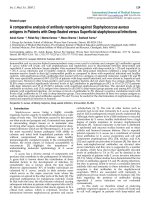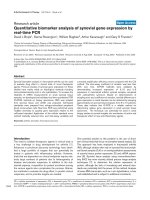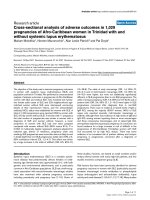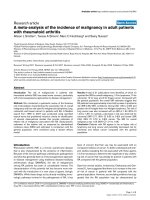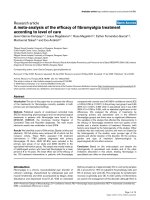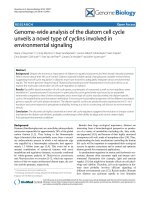Báo cáo y học: "Functional genomics analysis of low concentration of ethanol in human hepatocellular carcinoma (HepG2) cells. Role of genes involved in transcriptional and translational processes"
Bạn đang xem bản rút gọn của tài liệu. Xem và tải ngay bản đầy đủ của tài liệu tại đây (409.63 KB, 8 trang )
Int. J. Med. Sci. 2007, 4
28
International Journal of Medical Sciences
ISSN 1449-1907 www.medsci.org 2007 4(1):28-35
© Ivyspring International Publisher. All rights reserved
Research Paper
Functional genomics analysis of low concentration of ethanol in human
hepatocellular carcinoma (HepG2) cells. Role of genes involved in
transcriptional and translational processes
Francisco Castaneda
1
, Sigrid Rosin-Steiner
1
and Klaus Jung
2 3
1. Laboratory for Molecular Pathobiochemistry and Clinical Research, Max Planck Institute of Molecular Physiology,
Dortmund, Germany;
2. Department of Statistics, University of Dortmund, D-44221 Dortmund, Germany;
3. Medical Proteom-Center, Ruhr-University Bochum, D-44780 Bochum, Germany
Correspondence to: Francisco Castaneda, MD, Laboratory for Molecular Pathobiochemistry and Clinical Research, Max Planck Institute for
Molecular Physiology, Otto-Hahn-Str. 11, 44227 Dortmund, Germany; Tel. 49-231-9742-6490, Fax. 49-231-133-2699, E-mail:
Received: 2006.11.26; Accepted: 2006.12.15; Published: 2006.12.21
We previously found that ethanol at millimolar level (1 mM) activates the expression of transcription factors
with subsequent regulation of apoptotic genes in human hepatocellular carcinoma (HCC) HepG2 cells. However,
the role of ethanol on the expression of genes implicated in transcriptional and translational processes remains
unknown. Therefore, the aim of this study was to characterize the effect of low concentration of ethanol on gene
expression profiling in HepG2 cells using cDNA microarrays with especial interest in genes with transcriptional
and translational function. The gene expression pattern observed in the ethanol-treated HepG2 cells revealed a
relatively similar pattern to that found in the untreated control cells. The pairwise comparison analysis
demonstrated four significantly up-regulated (COBRA1, ITGB4, STAU2, and HMGN3) genes and one
down-regulated (ANK3) gene. All these genes exert their function on transcriptional and translational processes
and until now none of these genes have been associated with ethanol. This functional genomic analysis
demonstrates the reported interaction between ethanol and ethanol-regulated genes. Moreover, it confirms the
relationship between ethanol-regulated genes and various signaling pathways associated with ethanol-induced
apoptosis. The data presented in this study represents an important contribution toward the understanding of
the molecular mechanisms of ethanol at low concentration in HepG2 cells, a HCC-derived cell line.
Key words: human hepatocellular carcinoma cells, HepG2, ethanol, gene expression, transcriptional and translational
processes
1. Introduction
Studies using the human hepatocellular
carcinoma (HCC) cell line HepG2 have demonstrated
a specific gene expression pattern induced by ethanol
different from that observed in normal livers and in
livers with alcoholic liver disease [1, 2]. In vivo studies
using animal models, including rats [3], mice [4], and
baboons [5] as well as human liver samples obtained
from patients with advanced alcoholic liver disease [5],
revealed changes in the expression of genes coding for
transcription factors, signaling molecules, stress
response and ethanol metabolism [1]. These studies,
however, have been performed using high
concentrations of ethanol.
Gene expression profiling using microarray
technology allows the expression analysis of
thousands of genes simultaneously [6-8]. This method
is more informative than nonparallel studies on single
genes [9, 10] providing information of networks of
gene expression changes [11] [12]. The cDNA
microarray technique has been used to evaluate the
global gene expression in HCC as well as
HCC-derived cell lines [13-16]. Moreover, HepG2 cells
can be used to analyze the effect of ethanol on gene
expression in HCC, based on the fact that HepG2 cells
retain the genomic expression of HCC [15, 17, 18].
We previously reported the effect of ethanol at
low concentration (namely 1 mM) on induction of
different signaling pathways initiated through protein
kinases phosphorylation with subsequent expression
of transcription factors (AP1, Elk1, Stat1, SRF and
NFκB) and expression of apoptotic genes (Fas receptor,
Fas ligand, FADD and caspase 8) [19]. However, the
effect of low concentration of ethanol on genes
involved in transcriptional and translational processes
remains to be characterized. Therefore, the aim of this
study was to identify the effect of low concentration of
ethanol (1 mM for 6 h) on gene expression, specifically
from genes with transcriptional and translational
function, in HepG2 cells compared to HepG2 cells not
exposed to ethanol (control cells) using cDNA
microarrays. We identified four significantly
up-regulated (COBRA1, ITGB4, STAU2, and HMGN3)
Int. J. Med. Sci. 2007, 4
29
and one down-regulated (ANK3) gene. Notably, none
of these genes have been previously associated with
ethanol with the exception of ITGB4 that has been
found up-regulated with high concentrations of
ethanol.
This study represents an important advance in
the characterization of the molecular mechanisms of
low concentration of ethanol in HepG2 cells.
Moreover, it constitutes a necessary step in the
understanding of the molecular mechanisms involved
in alcohol-induced effect in human hepatocellular
carcinoma cells. In addition, this represents a novel
approach for the identification of potential targets in
the diagnosis and treatment of human hepatocellular
carcinoma.
2. Materials and methods
Cell culture and reagents
Based on the reported alteration of gene
expression of primary human hepatocytes in
monolayer cultures [20] and the conserved gene
expression profile in confluent HepG2 cells in vitro
[21], the present study was performed only using
HepG2 cells.
HepG2 cells were seeded in 250 ml tissue culture
flasks (Falcon, Heidelberg, Germany) at 1x10
5
/ml
concentration in 10 ml RPMI-1640 medium (Gibco,
Eggersheim, Germany) supplemented with 10% fetal
bovine serum (Boehringer Mannheim, Germany), 100
U/ml penicillin and 100 µg/ml streptomycin (ICN,
Meckenheim, Germany) at 37°C in a humidified
atmosphere of 7.5% CO
2
. The cells were grown to 80%
confluence. After 2 days of cell culture, the cells were
harvested with 0.05% trypsin / 0.02% EDTA (Gibco)
and seeded in 6-well plates (Falcon) at concentrations
of 1x10
5
/ml. Six sets of experiments were performed.
Each set consist of two groups as follow: group 1,
HepG2 treated cells with 1 mM ethanol for 6 h; and
group 2, HepG2 cells without ethanol exposure used
as a control. All chemicals were purchased from
Sigma Aldrich (Seelze, Germany).
Both the ethanol concentration at millimolar level
(1 mM) and the exposition time (6 hr) were chosen
based on the data obtained from previous studies
[22-24]. They demonstrated that ethanol at low
concentrations selectively induces apoptosis in HepG2
cells without causing cell toxicity, which represents
the hallmark of the ethanol effect when high
concentrations are applied [25].
Total RNA extraction and microarray hybridization
Total RNA was extracted using RNase kit
(Qiagen, Hilden, Germany) and its quality was
confirmed by electropherograms using a 2100
BioAnalyzer (Agilent, Santa Clara, CA). Total RNA (5
µg) were used for preparing biotinylated cRNA using
GeneChip IVT Labeling Kit (Affymetrix, Santa Clara,
CA). After confirmation of the quality of labeled
cRNA using the Affymetrix Test 3 Array, cRNA was
converted to cDNA using GeneChip One-Cycle cDNA
Synthesis Kit (Affymetrix). Fifteen micrograms of
labeled and fragmented cRNA were subsequently
hybridized to a Human Genome U133 plus 2.0
microarray (Affymetrix). After the hybridization, the
DNA microarrays were washed and stained on a
Fluidics Station (Affymetrix) according to
manufacturer’s instructions. Finally, the DNA
microarrays were scanned with a GeneChip Scanner
3000 (Affymetrix).
DNA microarray analysis
Data analyses were performed using the
GeneChip Expression Analysis Software (version 3.2,
Affymetrix). First, single array analysis was
performed [11] to calculate for each gene a signal,
which represents a relative measure of the abundance
of the transcript with a detection p-value. To evaluate
the gene expression profile between group 1
(ethanol-treated) and group 2 (control) a hierarchical
cluster analysis was performed [26-28].
For a quantitative estimation of the change in
gene expression between both groups a pairwise
comparison analysis was performed. For that purpose
a signal log ratio (SLR; basis 2) using a one-step
Tukey's biweight method was calculated [29] [30].
Genes with a SRL > 1 or <-1 in at least 3 experiments
(50%) were selected for further analyses.
Quantitative real-time PCR Analysis
Quantitative real-time PCR was used to validate
the effect of ethanol on gene expression. Total RNA
was isolated from HepG2 cells using RNAsy kit
(Qiagen) and RNA quality was evaluated using RNA
6000 Nano Chip Kit and Bioanalyzer 2100 (Agilent,
Böbligen, Germany). Real-time PCR was performed
using the QuantiTect SYBR green RT-PCR kit (Qiagen).
Specific primers for each selected gene were used. A
quantitative real-time PCR determination using the
Optical System Software (iQ5 version 1.0) provided
with the BioRad iQ5 cycler (BioRad, Munich, Ger-
many) was performed. The following primers were
used: ITGB4 forward,
5’-CCTGTACCCGTATTGCGACT-3’; ITGB4 reverse
5’-AGGCCATAGCAGACCTCGTA-3’; COBRA1 for-
ward 5’-TGAAGGAGACCCTGACCAAC-3’; COBRA1
reverse 5’-ATCGAATACCGACTGGTGGA-3’; ANK3
forward 5’-GGAGCATCAGTTTGACAGCA-3’; ANK3
reverse 5’-TTCCACCTTCAGGACCAATC-3’; STAU2
forward 5'-CCGTGAGGGATACAGCAGTT-3'; STAU2
reverse 5’-GCCCATTCAGTTCCACAGTT-3’; HMGN3
forward 5’-TGCCAGATTGTCAGCGAAAC-3;
HMGN3 reverse
5’-TGCTCCACCAAAACCTGAACCAAAC-3. All
primers were synthesized by MWG Biotech AG
(Ebersberg, Germany). Samples were prepared in
triplicate and real time PCR measurement for each
sample was done in duplicate. The expression level of
each gene was normalized using the control group
(group 2) and an induction ratio (treated/control) was
obtained. The average of duplicate real time PCR
measurements was used to calculate the mean induc-
tion ratio ± SD for each gene.
Int. J. Med. Sci. 2007, 4
30
Statistical analysis
Data are expressed as mean values ± standard
deviation (SD). Results from HepG2 cells treated with
1mM concentration of ethanol (group 1) were
compared to non-treated HepG2 cells (control cells,
group 2) using Student's t-test. Statistical significance
was assumed at p level <0.05 level. SigmaPlot
software version 8.02 (Systat Software, Erkrath,
Germany) was used for statistical analysis.
Statistical analyses of microarray data were
performed using a permutation procedure [31, 32] as
well as a non-parametric method [33]. These two
methods allowed us to analyze whether a gene had no
expression change (null hypothesis) or whether it did
(alternative hypothesis). Based on the expression
measurements, a decision is made either for the null
or the alternative hypothesis. In order to keep the
number of false positive decisions small, the two
testing procedures were set up to control for the
family-wise error rate (FWER), which is the
probability of having more than one false positive
decision among all n tests. In particular, the testing
procedures guaranteed an FWER ≤ 0.05 [34].
3. Results
Low concentration of ethanol selectively expresses
genes involved in transcriptional and translational
processes
Figure 1 shows the hierarchical gene expression
profile of 1 mM ethanol concentration treated HepG2
cells (group 1) and control cells (HepG2 cells without
treatment; group 2) exposed for a 6 h period. Data are
presented as a median of the signal obtained from the
six different microarrays for each group (n=6). Each
single array had good quality control and showed a
normal distribution and linearity. The red zones
indicate up-regulated gene expression and the green
zones indicate down-regulated gene expression. The
gene expression pattern between the two groups
revealed a relatively similar pattern, suggesting that
only few genes are changed with exposure of a low
concentration of ethanol. The pairwise comparison
analysis demonstrated the selective effect of ethanol
on fives genes involved in transcriptional and
translational processes. As shown in Table 1, the
up-regulated genes were COBRA1, ITGB4, STAU2,
and HMGN3 with a SLR of 3.30, 2.61, 1.68 and 1.52,
respectively. ANK3 was the only significantly
down-regulated gene with a SLR of -5.02.
Figure 1. Hierarchical clustering analysis of gene expression
profile in ethanol-treated HepG2 cells (1 mM ethanol for 6 h,
Group 1) compared to control HepG2 cells (Group 2). Each
row represents the mean of signal log ratios (n=6 arrays each
group) using a color-code scale. Red represents expression
greater than reference, green is less than reference, and gray
is missing or excluded data.
Table 1. Ethanol-regulated genes obtained from the pairwise comparison analysis between ethanol-treated (1 mM for 6 h) and
control HepG2 cells.
Probeset Gene
symbol
Gene title Signal Log
Ratio
Function Gene ID
202757_at COBRA1 cofactor of BRCA1 ▲ 3.30 regulation of transcription NM_015456
204990_s_at ITGB4 integrin, beta 4 ▲ 2.61 protein binding NM_000213
204226_at STAU2 staufen, RNA binding protein, homolog 2
(Drosophila)
▲ 1.68 double-stranded RNA
binding
NM_014393
209377_s_at HMGN3 high mobility group nucleosomal binding
domain 3
▲ 1.52 DNA binding NM_004242
206385_s_at ANK3 ankyrin 3, node of Ranvier (ankyrin G) ▼ 5.02 protein binding NM_001149
▲- increased
▼- decreased
Validation of microarray results by quantitative real
time RT-PCR analyses
In order to validate the observed expression on
the ethanol-regulated genes (COBRA1, ITGB4, STAU2,
HMNG3, and ANK3), we performed quantitative real
time RT-PCR in HepG2 cells treated with ethanol. The
primers used showed a linear specificity. The results
were normalized to control mRNA level (i.e. HepG2
cells without ethanol treatment). We did not use
housekeeping genes, such as GADPH, actin or LDHA,
because ethanol also alters the expression of these
genes (data not shown). The relative mRNA level for
each gene is shown in Figure 2. The obtained mRNA
Int. J. Med. Sci. 2007, 4
31
level for COBRA1, ITGB4, STAU2, and HMGN3 was
38.0, 22.7, 5.5, and 3.8, respectively. In the case of
ANK3, the real time RT-PCR did not give any
transcript with two different primers. This might be
due to the strong down-regulation of ANK3 observed
with ethanol treatment. The results from
semi-quantitative RT-PCR quantified and confirmed
the findings of the microarray analysis on gene
expression in response to ethanol.
Figure 2. Validation of ethanol-regulated genes by real time
RT-PCR. mRNA levels of ethanol-regulated genes
determined by real time RT-PCR. Induction ratios of each
gene (fold change) by ethanol were calculated using
expression level, normalized to the level of the control group
(HepG2 without ethanol treatment). Experiments were done
in triplicate (n=3) and error bars indicate standard deviation
among the triplicate samples.
Gene ontology analysis
Once the ethanol-regulated genes were validated,
we analyzed further their implication in different
biological processes. For this purpose, the
ethanol-regulated genes were functionally clustered
into specific biological processes from the
classification systems of the gene ontology annotation
[35]. The gene ontology analysis of the identified
genes is shown in Table 2. The biological processes
associated with the up-regulated genes in the
ethanol-treated HepG2 cells were as follow: regulation
of transcription for COBRA1; cell communication, cell
adhesion, cell-matrix adhesion, integrin-mediated
signaling, and development for ITGB4; transport for
STAU2; and an unknown biological process for
HMGN3. The biological processes in which ANK3, the
down-regulated gene, was involved were protein
targeting, cytoskeletal anchoring and signal
transduction.
Additionally, we evaluated the functional
pathways in which the ethanol-regulated genes were
involved using KEGG (Kyoto Encyclopedia of Genes
and Genomes) [36] and GenMAPP (Gene Microarray
Pathway Profiler) [37] analysis. As shown in Table 2,
only ITGB4 was found to be involved in intracellular
pathways including cell communication, focal
adhesion, extra cellular matrix-receptor interaction
and regulation of cytoskeleton. These data suggest an
important role of integrin in the molecular
mechanisms of ethanol effects in HepG2 cells. The
other ethanol-regulated genes were not found to be
associated with any specific pathway.
Table 2. Gene ontology in terms of biological processes of the ethanol-regulated genes in HepG2 cells.
Gene symbol Gene ontology (GO) biological process KEGG/ GenMAPP Pathway
GO:0006350 transcription -- COBRA1
GO:0006355 regulation of transcription, DNA-dependent
--
GO:0007154 cell communication hsa01430 Cell Communication
GO:0007155 cell adhesion hsa04510 Focal adhesion
GO:0007160 cell-matrix adhesion hsa04512 ECM-receptor interaction
GO:0007229 integrin-mediated signaling pathway hsa04810 Regulation of actin cytoskeleton
ITGB4
GO:0007275 development --
STAU2 GO:0006810 transport --
HMGN3 GO:0008150 biological process unknown --
GO:0006605 protein targeting
GO:0007016 cytoskeletal anchoring
ANK3
GO:0007165 signal transduction
--
Functional genomics analysis of ethanol-regulated
genes
In an effort to find gene regulatory networks
associated with low concentration of ethanol, we
analyzed the interaction between the
ethanol-regulated genes studied using Pathway
Architect software (Stratagene). Figure 3A shows the
reported interactions of each of these genes. ITGB4
and ANK3 are associated with different targets,
including small molecules, genes and proteins. In
contrast, COBRA1, STAU2 and HMGN3 are only
associated with very few targets. Figure 3B shows the
reported interaction network between ethanol and the
five ethanol-regulated genes of interest. Of note,
ITGB4, COBRA1 and ANK3 are indirectly associated
with ethanol through phosphatidylinositol, GTP and
chloride, respectively. There are until now no reported
interactions observed for STAU2 and HMGN3. Figure
3C shows the interaction of ethanol with similar
signaling pathways, in which ethanol-regulated genes
are also involved. Such pathways include ERK-PI3K,
AKT, NO, cAMP-PKA, PTEN, G-Protein-MAPK, NGF,
and PDGF signaling. This finding corroborates the
interaction observed between various intracellular
signaling pathways and apoptosis induced by 1mM
concentration of ethanol in HepG2 cells [19].
Int. J. Med. Sci. 2007, 4
32
Figure 3. Functional genomics of low concentrations of ethanol in HepG2 cells. (A) Reported interactions of each
ethanol-regulated gene studied. (B) Indirect interaction of ITGB4, COBRA1 and ANK3 with ethanol, as reported in the
literature. (C) Interaction of ethanol with similar signaling pathways in which COBRA1, ITGB4, STAU2, HMGN3, and ANK3
are also involved.

